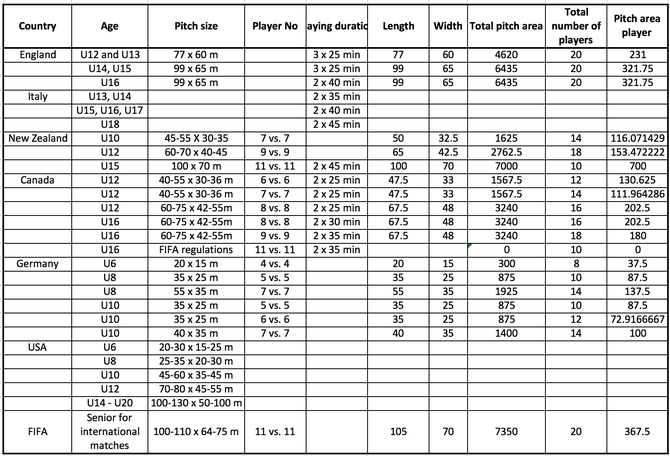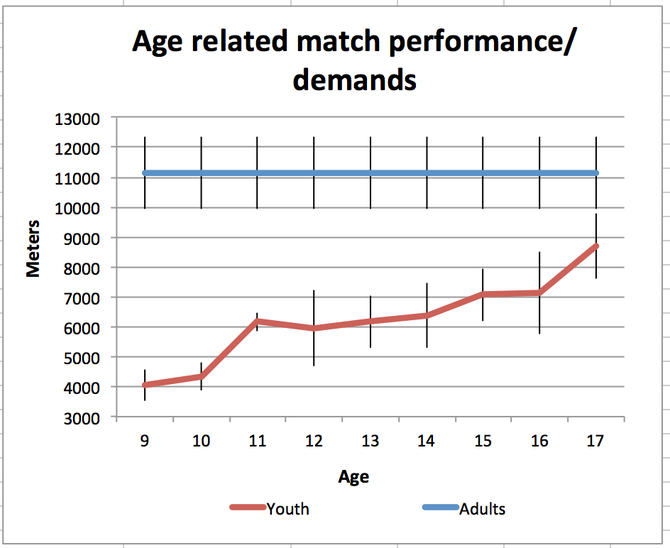Physical/physiological demands in different age groups
Youth players are not miniature adults. However, there seemed to be limited research with regards to actual game/match analysis. As a result the physical/physiological demands of the game and
therefore possible resulting training guidelines are very limited for specific age/maturation groups.
Situational variances
Naturally, youth players play on different size pitch and include lower number of players in many age groups.
As on overview I have tried to include as much information from different countries regarding pitch size, number of players and duration of games.
Depending on the total pitch area and the number of players, the individual pitch area will vary. Consequently and due to the greater individual pitch size for adults, differences in physical and
physiological variables from adults to youth players might partly be explained already.
Physical/physiological aspects
However, as youth players (depending on age and maturation) inherent lower strength, aerobic and anaerobic capacity (1), glycogen stores (2) and less well-developed thermoregulatory responses
(3), on-pitch performances differ from adults.
Generally, it seems that match performance increase with age (4) and the available literature suggests that young soccer players cover between 5 to 8 km per match, which is 3 to 4 km less than
adults (5-11).
Positional roles
It seems that similar to adult football (12, 13), position roles have impact on match performance/demands (4, 14, 15).
Youth midfielders cover greater distance compared to defenders and strikers (9). Furthermore centre-backs covered the lowest total distance and underwent the least high-intensity activities in
comparison to wingers and strikers (4)
As a result, the position needs to be taken into account in the players development. However, selecting a position too early in the development process seems to favor loss of physical ability and
tactical skills (16).
Conclusion
As a result, youth footballers cover lower total distances, produce a smaller number and frequency of high-intensity activities during match play compared to adults due to the physiological differences, maturity status as well as shorter duration of playing time during a game (14).
However and controversially, research (17) also suggests when accounting for speed thresholds that younger players tend to do more sprinting (18) and run the same total distance (19).
Furthermore, age-related differences in between-half variations in match running performance have also been suggested (20), with younger players being able to maintain high-intensity running in
the second half better than older players (20, 21).
From a developmental point of view it seems that physical match performances of youth players is closing the gap to adults football approximately 3-4 years after PHV approximately at around
17 (-18) years of age.
References
1. Atan SA, Foskett A, Ali A (2014) Special populations: Issues and considerations in youth soccer match analysis.
International Journal of Sports Science 4(3): 103-114.
2. Alvarado U (2005) Nutrition for young soccer players. International Journal of Soccer and Science 3(1): 12-20.
3. Rowland T (2008) Thermoregulation during exercise in the heat in children: old concepts revisited. J Appl Physiol
(1985) 105(2): 718-24.
4. Buchheit M, Mendez-Villanueva A, Simpson BM, Bourdon PC (2010) Match running performance and fitness in
youth soccer. Int J Sports Med 31(11): 818-825.
5. Mohr M, Krustrup P, Bangsbo J (2005) Fatigue in soccer: a brief review. J Sports Sci 23(6): 593-539.
6. Goto H, Morris JG, Nevill ME (2013) Match Analysis of U9 and U10 English Premier League Academy Soccer
Players using a Global Positioning System: Relevance for Talent Identification and Development. Journal of Strength and Conditioning Research.
7. Capranica L, Tessitore A, Guidetti L, Figura F (2001) Heart rate and match analysis in pre-pubescent soccer
players. J Sports Sci 19(6): 379-384.
8. Rebelo A, Brito J, Seabra A, Oliveira J, Krustrup P (2014) Physical match performance of youth football players in
relation to physical capacity. Eur J Sport Sci 14 Suppl 1: S148-56.
9. Castagna C, Manzi V, Impellizzeri F, Weston M, Barbero Alvarez JC (2010) Relationship between endurance field
tests and match performance in young soccer players. Journal of Strength and Conditioning Research 24(12): 3227-333.
10. Reilly T, Bangsbo J, Franks A (2000) Anthropometric and physiological predispositions for elite soccer. Journal of
Sports Sciences 18(9): 669-683.
11. Carling C, le Gall F, Reilly T, Williams AM (2009) Do anthropometric and fitness characteristics vary according to
birth date distribution in elite youth academy soccer players? Scand J Med Sci Sports 19(1): 3-9.
12. Rampinini E, Coutts AJ, Castagna C, Sassi R, Impellizzeri FM (2007) Variation in top level soccer match
performance. International Journal of Sports Medicine 28(12): 1018-1024.
13. Bradley PS, Di Mascio M, Peart D, Olsen P, Sheldon B (2010) High-intensity activity profiles of elite soccer
players at different performance levels. J Strength Cond Res 24(9): 2343-2351.
14. Aslan A, Acikada C, Guvenc A, Goren H, Hazir T, et al. (2012) Metabolic demands of match performance in
young soccer players. J Sports Sci Med 11(1): 170-9.
15. Stroyer J, Hansen L, Klausen K (2004) Physiological profile and activity pattern of young soccer players during
match play. Med Sci Sports Exerc 36(1): 168-74.
16. Malina RM, Pena Reyes ME, Eisenmann JC, Horta L, Rodrigues J, et al. (2000) Height, mass and skeletal
maturity of elite Portuguese soccer players aged 11-16 years. J Sports Sci 18(9): 685-93.
17. Mendez-Villanueva A, Buchheit M, Simpson B, Bourdon PC (2013) Match play intensity distribution in youth
soccer. Int J Sports Med 34(2): 101-10.
18. Buchheit M, Mendez-villanueva A, Simpson BM, Bourdon PC (2010) Repeated-sprint sequences during youth
soccer matches. Int J Sports Med 31(10): 709-716.
19. Harley JA, Barnes CA, Portas M, Lovell R, Barrett S, et al. (2011) Motion analysis of match-play in elite U12 to
U16 age-group soccer players. Journal of Sport Sciences 28(13): 1391-1397.
20. Castagna C, Impellizzeri F, Cecchini E, Rampinini E, Alvarez JC (2009) Effects of intermittent-endurance fitness
on match performance in young male soccer players. Journal of Strength and Conditioning Research 23(7): 1954-1959.
21. Castagna C, D'Ottavio S, Abt G (2003) Activity profile of young soccer players during actual match play. J
Strength Cond Res 17(4): 775-80.
22. Nakazawa M, Ishii T, Matsuda S, Kurogi H, Nagahori KN, et al. Analysis of match activities in high school
soccer players using a mobile GPS and VTR methods. in International Symposium on Biomechanics in Sports. 2005. Beijing, China.
 Footballscience.net
Footballscience.net



